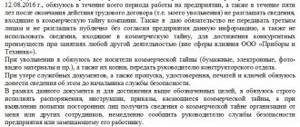What is a trade secret?
This term usually refers to information that is not generally known or easily accessible, but is valuable precisely because third parties are not familiar with it. Usually this is production, economic, financial information, production secrets, etc.
The need to protect such data is primarily due to the ever-increasing competition in the market. For the sake of valuable information, many are willing to spend a large sum or provide other benefits to the person who provides them. Leaks happen frequently enough that consideration of liability issues is not uncommon these days.
The protection of information constituting a trade secret comes down not only to signing non-disclosure agreements or limiting the circle of persons who have access to information. When these measures do not produce the desired effect, the interests of the injured party are defended in court.
Secret at a reasonable price
The Investigative Committee announced the existence of such a case and the arrest the day before, but in this message it did not mention the name of the person or the organization to which it concerned. Now the official representative of the Investigative Committee, Svetlana Petrenko, told the RG correspondent the following:
— As part of a criminal investigation into the illegal disclosure of information constituting a trade secret, the Main Directorate for Investigation of Particularly Important Cases of the RF IC has charged the former First Deputy General Director, Chief Engineer of Transneft-Diascan JSC Sergei Zubin.
Zubin is charged under Part 3 of Article 183 of the Criminal Code of the Russian Federation - “illegal disclosure of information constituting a commercial secret, committed out of selfish interest.” This means that he faces a real sentence of up to 5 years.
Petrenko says that, according to their version, while working at Transneft-Diascan, Zubin illegally received design documentation for certain devices. The Investigative Committee said about them that they are intended for diagnostics at oil industry facilities. Zubin received the documents, the department emphasized, without the consent of the owner. According to experts, the costs of these developments amounted to more than 2 billion rubles.
Cases of dismissal at the initiative of superiors for disclosing official secrets are not uncommon in the courts.
The Investigative Committee explained that in July 2021, Zubin quit his job, and in 2021, he invited a businessman he knew to buy part of these securities from him for 400 million rubles. Zubin was detained red-handed immediately after handing over the documents and receiving the money by the Investigative Committee officers together with the “P” department of the FSB Economic Security Service.
The department claims that he has already admitted his guilt and repented.
The main document that describes the concept of a trade secret. - this is the Federal Law (dated July 29, 2004 No. 98) “On Trade Secrets”.
And responsibility for disclosing such a secret is provided for by various legislative norms.
There is disciplinary liability - this is dismissal “at the initiative of the employer.” It is spelled out in the Labor Code.
Administrative responsibility is specified in Article 13.14. Code of Administrative Offenses of the Russian Federation. For disclosing information, with the exception of criminal cases like Zubin's, considerable fines are paid.
The article presented by the Investigative Committee is the most severe. Under it, you can receive a minimum fine of up to five hundred thousand rubles. Or correctional labor for up to one year, or forced labor for up to two years, or imprisonment for the same period.
If the secret is revealed by someone to whom it was entrusted at work, the fine immediately increases to one million rubles. This article offers the court's choice of correctional labor for two years or forced labor for three years. Well, or a colony for a couple of years.
If the disclosed secret caused major damage, the fine will increase to one and a half million, and the term of up to five years. True, the maximum punishment under this article will send a citizen to five years of forced labor or to a colony for up to seven years.
In recent years, experts have not recalled a single case of criminal punishment for disclosing trade secrets. But the same cannot be said about disciplinary punishments for such things.
Cases of dismissal of employees at the initiative of their superiors for disclosing official secrets are not uncommon in our courts. Citizens are trying to challenge the dismissals. Most employers stipulate the preservation of their trade secrets in contracts when they hire a person.
And in such situations, the courts, as a rule, side with the employer.
Trade secret regime
The law regulating this issue was adopted in 2013. It is worth noting that the data must meet certain requirements. Otherwise, they are not recognized as a trade secret. So, to set the mode, the information must:
- not be publicly available and generally known in the circles that usually deal with them;
- have commercial value precisely due to secrecy;
- not be the object of exclusive rights to intellectual activity and its results;
- not be state secrets.
According to the law, a trade secret regime cannot be established in the following cases:
- when the information is contained in constituent documents;
- when they are included in the Unified State Register;
- when they are contained in documents giving the right to start a business;
- when they are medical, lawyer, tax and other secrets protected by law;
- when they contain information about the development of republican or local budgets;
- when information about the number and composition of employees, working conditions, and availability of vacancies is implied;
- when it contains information about debts for wages and social benefits;
- when it comes to papers with data on the state of the environment, fire safety, etc.
In such cases, the protection and protection of trade secrets is impossible.
The right to establish this regime belongs to the person who possesses this information on the grounds permitted by law. Please note that classified information must not be treated in the same way by another person. In other words, you cannot “borrow” know-how during cooperation and claim protection under the law. The limits of authority in such situations are regulated by current regulations and the agreement signed between the parties.
A confidentiality agreement, like any other civil contract containing clauses on obligations to keep information received secret, must be drawn up in writing and contain a specific list of this information, the procedure for determining it, the limits of use and the period during which the data is not stored. must be disclosed. The validity of such agreements for the protection of trade secrets extends even in cases where the cooperation agreement is terminated. This also applies to situations where a document is declared invalid.
It is worth noting that the counterparty itself takes measures to protect confidential data. By the way, in relation to third parties, he has the same rights to protection as the owner of a trade secret.
Protection of trade secrets: effective business without leaks
Many citizens and entrepreneurs use the term “trade secret” when they want to hide from prying eyes how to achieve their success and information that allows them to make their business unique. It is the legal mechanism that allows you to call your information a “trade secret” that will be discussed in our material. The whole point of introducing this mechanism comes down to a certain, but quite feasible even in a micro-enterprise, level of secrecy, the observance of which is carried out under pain of prosecution, even criminal liability.
In this article we will talk about how the trade secret regime is introduced and how, by protecting trade secrets, you can make your business more protected from leaks of commercially attractive information and reduce the risk of its cloning by unscrupulous employees, former partners or simply dishonest entrepreneurs.
The most common situations when the introduction of a trade secret regime is necessary:
- to prevent former employees from using databases, incl. clients, suppliers, etc., commercially profitable developments of both the employee and his colleagues obtained in your organization;
- when attracting an investor who will gain access to the operational management of the business;
- in the case of the specifics of the business and the ease of cloning it by an employee or former partner;
- to prevent commercial espionage (information about the entry of goods or services into the market, commercial conditions for working with clients and partners, the results of patented developments);
- when creating other intellectual property objects that are the main asset of the company.
To better understand what can be classified as a trade secret, let's define the terms:
- trade secret (CT) - a regime of confidentiality of information that allows its owner, under existing or possible circumstances, to increase income, avoid unjustified expenses, maintain a position in the market for goods, works, services, or obtain other commercial benefits;
- information constituting a trade secret - information of any nature (production, technical, economic, organizational and others), including the results of intellectual activity in the scientific and technical field, as well as information about methods of carrying out professional activities that have actual or potential commercial value due to their unknownness to third parties, to which third parties do not have free access on a legal basis and in respect of which the owner of such information has introduced a trade secret regime.
The need to prevent information leakage arises where work involves confidential information that guarantees profit, secret production or patented technologies. In short, a trade secret is a concept consisting of:
- a special regime for the protection of information, allowing its creator to increase income and avoid unjustified expenses;
- introducing and consolidating internal measures to prevent information leakage;
- the information itself, which is secret and inaccessible to unauthorized persons due to the adopted confidentiality regime;
- a legally formalized procedure for transferring information containing CT to other persons only after taking organizational and legal measures to protect such information under an agreement with its owner.
The trade secret regime in the private sector cannot be established in relation to the following information:
- contained in the constituent documents of a legal entity, documents confirming the fact of inclusion in the Unified State Register of Legal Entities and the Unified State Register of Individual Entrepreneurs;
- contained in documents giving the right to carry out business activities (licenses, certificates, permits, etc.);
- about environmental pollution, the state of fire safety, the sanitary-epidemiological and radiation situation, food safety and other factors that have a negative impact on ensuring the safe operation of production facilities, the safety of each citizen and the safety of the population as a whole;
- on the number, composition of employees, the remuneration system, working conditions, including labor protection, indicators of industrial injuries and occupational morbidity, and the availability of vacancies;
- about the debt of employers in payment of wages and other social benefits;
- about violations of the legislation of the Russian Federation and facts of prosecution;
- on the list of heads of legal entities;
- the mandatory disclosure of which or the inadmissibility of restricting access to which is established by other federal laws (for example, in relation to accounting (financial) statements).
The trade secret regime is not a bureaucratic extravagance divorced from reality and is not the preserve of organizations working on secret projects. Any organization or simply a person who does not want their commercially attractive information for competitors not to be used freely and uncontrollably is required to introduce such a regime.
a trade secret regime or not and in relation to what information. In real activities, a trade secret can be:
- database and information resources of the company;
- management accounting and financial indicators of the organization (profit and costs for a certain period, cost per unit of production, the amount of receivables and payables of the organization, cash balances and other indicators);
- work methodology (sales, service provision, production, technical methods and approaches, etc.), incl. know-how;
- plans for the development of production or sales of goods (the organization’s entry into new markets, the creation of branches and representative offices, the creation of a fundamentally new product, etc.);
- terms and conditions of transactions entered into and concluded;
- information about technical means of protecting the organization’s property, security and other alarm systems, methods and techniques for ensuring the safety of the organization’s activities;
- development results before patenting and registration, etc.;
Disclaimers in contracts stating that “the contents of this contract are a trade secret” do not give anything at all. A trade secret becomes such only from the moment its legal owner establishes the CT regime, which includes 5 mandatory actions:
- determination of the list of information that makes up the CT;
- restricting access to CT by establishing a procedure for handling this information and monitoring compliance with such a procedure;
- accounting of persons who received access to CT and/or persons to whom such information was provided or transferred;
- determine the procedure for using CT with employees and contractors in contracts with them;
- applying to tangible media with CT or including in the details of documents with CT the stamp “Trade Secret” indicating the owner of such information (for legal entities - full name and location, for individual entrepreneurs - full name and place of residence).
It is important to understand that information that at the time of the proposed introduction of the CT regime is in the public domain or has access to at least one third party other than its “creator” cannot subsequently become confidential. Similarly, if the information was transferred to a person with whom there was no non-disclosure agreement, and he was not provided with a list of information containing CT, then such information loses the status of CT, regardless of what measures were taken to protect it previously.
Advice: if you need to provide information containing CT scans to the court, then you must:
- provide evidence of the introduction of the CT regime and the inclusion of information requested by the court or provided by you on your own initiative to the list of CT in you or in your organization;
- submit a request in advance to hold a closed court hearing;
- make sure that the judge has taken the receipt from the persons participating in the case, their representatives, as well as experts, witnesses and translators if they participate in the proceedings on liability for the disclosure of such information;
- then provide the necessary information to the court.
When creating a list of information containing CT, one must pragmatically take into account that:
- the costs of ensuring the protection of CT must be less than the expected damage in the event of disclosure;
- the protected CT should increase the economic efficiency of the enterprise (give an advantage in the market).
In order to protect CT, the employer is obliged to:
- familiarize, against signature, the employee whose access to the CT is necessary for the employee to perform his or her job duties with the list of information that makes up the CT;
- familiarize the employee, against signature, with the CT regime established by the employer and with the measures of liability for its violation (disciplinary, administrative, civil and criminal);
- create the necessary conditions for the employee to comply with the CT regime established by the employer.
An employee’s access to information constituting a trade secret is carried out with his consent, if this is not provided for by his job duties, and therefore, in order to eliminate the need to obtain consent, it must be immediately included in the employment contract as an obligation to preserve the CT, and if the CT regime is introduced later, then conclude an additional agreement to the employment contract.
All documents establishing a trade secret regime must be stored in the organization permanently (Article 62 of the List approved by order of the Ministry of Culture of Russia dated August 25, 2010 No. 558).
Responsibility for violating the trade secret regime
- Disciplinary liability in relation to employees . An employment contract can be terminated with an employee at the initiative of the employer, i.e. the employee can be dismissed for a one-time gross violation of labor duties - in the event of disclosure of a secret protected by law (state, commercial, official, etc.), which became known to the employee in connection with the performance of his labor duties. responsibilities, including disclosure of personal data of another employee (clause “c” of paragraph 6 of Article 81 of the Labor Code of the Russian Federation). At the same time, the burden of proving that such information relates to a secret protected by law or personal data falls on the employer (clause 43 of the Resolution of the Plenum of the Supreme Court of the Russian Federation of March 17, 2004 No. 2 “On the application by the courts of the Russian Federation of the Labor Code of the Russian Federation”). Such dismissal is a disciplinary measure and in order for it to be carried out legally, the procedure for bringing to disciplinary liability must be followed.
- Civil liability. in the form of recovery of losses (Article 15 of the Civil Code of the Russian Federation), i.e. expenses that the owner of the CT has incurred or will incur to restore the situation before the violation of the CT regime, as well as lost profits from the disclosure of such information.
- the amount of losses agreed upon in the event of disclosure of CT (Part 1 of Article 1472 of the Civil Code of the Russian Federation) with the employee or other person.
- Collecting information constituting commercial, tax or banking secrets by stealing documents, bribery or threats, as well as in any other illegal way - is punishable by a fine of 500 rubles or in the amount of the wages or other income of the convicted person for a period of up to 1 year, or by correctional labor for up to 1 year, or forced labor or imprisonment for up to 2 years.
The procedure for disclosing trade secrets to authorities
Classifying information as CT does not exclude the obligation to provide it to law enforcement, as well as other authorized government bodies, which are granted by law the right to receive relevant information within their competence.
- The owner of the information constituting the CT, at the motivated request of the government authority, provides them with such information free of charge.
- A reasoned request must be signed by an authorized official, contain an indication of the purpose and legal basis for requesting information constituting Kb, and the deadline for providing this information.
- In case of refusal, the authorities may apply to the court to request a CT
- The owner of the information constituting the CT, the government agencies that received it, are obliged to provide this information at the request of the courts, preliminary investigation bodies, and inquiry bodies in cases under their investigation.
- Documents provided to authorities and containing information constituting CT must be stamped “Trade Secret” identifying its owner.
Author: Stanislav Solntsev, managing partner of the legal
Illustrations: Alina Mkrtchyan, 2021
Do you have a similar situation?
A Step-by-Step Guide to Establishing Trade Secret Regime
- Making an appropriate decision in writing with the appointment of a specific responsible person.
- Development of an action plan to establish a regime (organizational actions, provision of secret information to the responsible person, technical and legal measures).
- Determination of the composition of data that is subject to legal protection of a trade secret.
- Restricting access to classified information. This is done by regulating the procedure for contacting data carriers and supervising compliance with this document.
- Organization of registration of persons having access to secret information.
- Inclusion of relevant clauses in employment agreements (contracts) of employees.
I would like to dwell on the last point in more detail. The document concluded between the employer and the employee should reflect all general provisions. Let’s say right away that no one has canceled the signing of a separate non-disclosure agreement, since only such a step will fully protect your trade secrets. The employment agreement (contract) specifies the rights and obligations of the parties, the procedure for handling data media, liability in case of violation of the agreement, the duration of the obligation on the part of the employee and the employer (for example, in a situation where he did not notify about the abolition of the trade secret protection regime).
The main advantage of a non-disclosure agreement over employment documents is that termination of cooperation does not relieve responsibility for the dissemination of secret information. By the way, refusal to sign is one of the grounds for terminating the contract.








